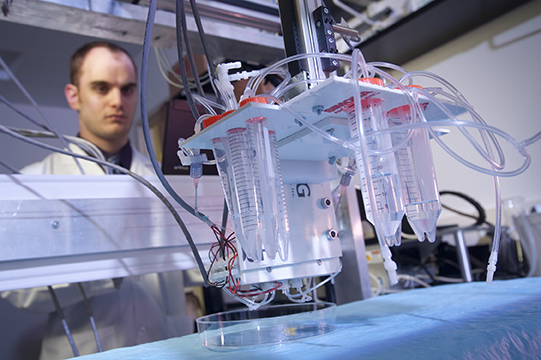USAMRMC Partnering to Open New Avenues of Opportunity

As tactical warfare has evolved, so have the ways to treat injuries and casualties in the field, calling for a mix of science and technology, practices and techniques, and lessons learned, all with an eye to the future.
The injuries service members sustain today are often severe, destructive and complex and can affect them for the rest of their lives. For example a blast injury from an improvised explosive device can simultaneously cause burns, amputations, nerve damage and a traumatic brain injury.
The USAMRMC's mission is to help those Warfighters restore their health as much as possible so that they can lead fulfilling lives. The command provides research and further develops products that support the Army's goal of establishing and maintaining the capabilities required to win on the battlefield in this complex world.
"Why we do what we do is at the core of everything that happens at the USAMRMC," said Dr. Kenneth Bertram, USAMRMC Principal Assistant for Acquisition. "From the research to advanced development to fielding and logistics ' it is all about a single mission: saving lives. We keep that in mind with every new project we begin because that is what motivates and inspires us more than anything else: to deliver innovative products and cutting-edge solutions that keep our sons and daughters safe on the battlefield."
The command could not accomplish its mission without partnerships. In fact, USAMRMC accomplishes most of its work extramurally and through contracts or partnerships with large and small businesses, organizations and universities.
Doing business with companies is a win-win, said Bertram.
THE NEED FOR BETTER COLLABORATIONS
"We are able to take items already being researched, but may have a use for Soldiers, that the average citizen wouldn't encounter and leverage the research already being conducted to benefit our end goal of warfighter health," he said. "This saves us time and the taxpayer's money, and most of the research translates in some way to public health."
Faced with the need to broaden collaboration with the research and development community while streamlining the contracting process to field medical solutions faster, the USAMRMC is leveraging a new type of collaboration.
The Medical Technology Enterprise Consortium is a group of industry, academic and other entities organized and operated through Applied Technologies International (ATI), a 501(c)(3) nonprofit corporation based in North Charleston, South Carolina. Its relationship with the USAMRMC is based on a prototype Other Transaction Agreement.
The command explored Other Transaction Authority, a special vehicle that federal agencies use to obtain or advance research and development or prototypes, in order to reach nontraditional contractors and small businesses. OT Agreements for prototype development are not subject to the Federal Acquisition Regulation. Additionally, private-sector funding is available for R&D in military medicine but is largely unreachable by the USAMRMC.
A MULTIFACETED MISSION
The USAMRMC awarded the agreement to SCRA Applied R&D (parent organization to ATI) in August 2015 through a competitive solicitation, to organize and operate the MTEC, which is expected to be self-sustaining by 2018. The MTEC's mission is to assist the USAMRMC by providing cutting-edge technologies and effective materiel life cycle management to transition medical solutions to industry that protect, treat and optimize service members' health and performance across the full spectrum of military operations.
The MTEC has the following principal objectives: (a) conduct research and prototyping to support the USAMRMC requirements; (b) capitalization of private-sector and government opportunities; (c) provide funding for critical studies that may attract other investors; and (d) commercialization of government intellectual property.
MTEC plans to fund prototyping projects through a competitive process using both public and private funds.
MTEC's first solicitation focused on manufacturing initiatives in regenerative medicine. After the solicitation closed, all proposals were assessed for their value and priority against set evaluation criteria. One key way in which working through MTEC differs from contracting is the freedom to have open discussion between the offerors and sponsor during the evaluation period. MTEC can provide feedback and the offerors then update and resubmit their proposals. Four awards were announced in August 2016 ' less than six months after the solicitation was released.
Regenerative medicine is a rapidly growing area of science that aims to unlock the body's own ability to rebuild, restore or replace damaged tissue and organs. Regenerative Medicine research is also funded by USAMRMC using standard assistant agreements for more basic and applied research. The prototyping OT will enable more advanced studies and collaborative efforts to more efficiently reach both military and civilian needs.
Dr. Lester Martinez Lopez, a retired Army major general, serves as president and chairman of the MTEC Board of Directors. A former commander of the USAMRMC, Lopez appreciates firsthand the challenges of rehabilitating our Wounded Warriors and restoring their quality of life to the maximum extent achievable through medical science.
"As a nation, we owe nothing short of our absolute best efforts to help those who have taken the brunt of combat on our behalf (to) recover their physical and mental capacities to the point that they can return to productive activities in their post-military lives," said Lopez. "MTEC presents an innovative opportunity that can break down government-industry-academia barriers in a way that facilitates the rapid advancement of leading-edge technologies into devices and therapeutics."
CONCLUSION
MTEC's mission is to assist the USAMRMC and others by providing cutting-edge technologies to transition medical solutions to marketplace. These technologies will protect, treat and optimize the health and performance of service members across the full spectrum of military operations.
"We want to harness the research in this field to treat these traumatic injuries that we see our service members sustain," said Bertram. "The need to find innovative solutions to heal these types of wounds and injuries is imperative to the immediate and long-term health of our servicemen and women. MTEC offers us one more avenue of opportunity to find these solutions more quickly."
For more information about MTEC Ms. Stacey Lindbergh, Executive Director, MTEC at
stacey.lindbergh@scra.org, 843-760-3566
(mtec-sc.org ).
).














